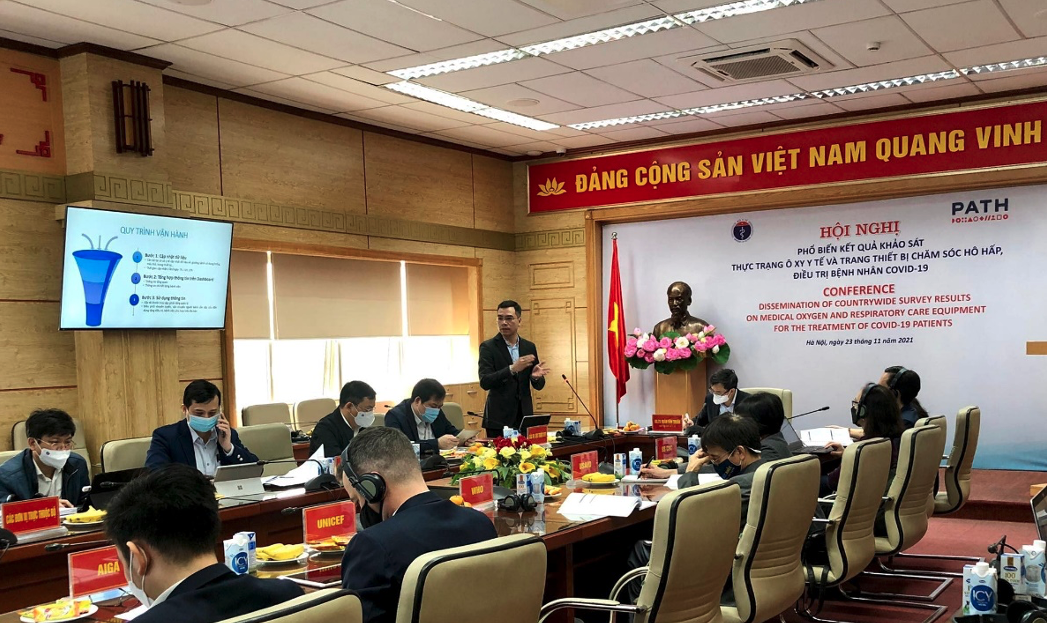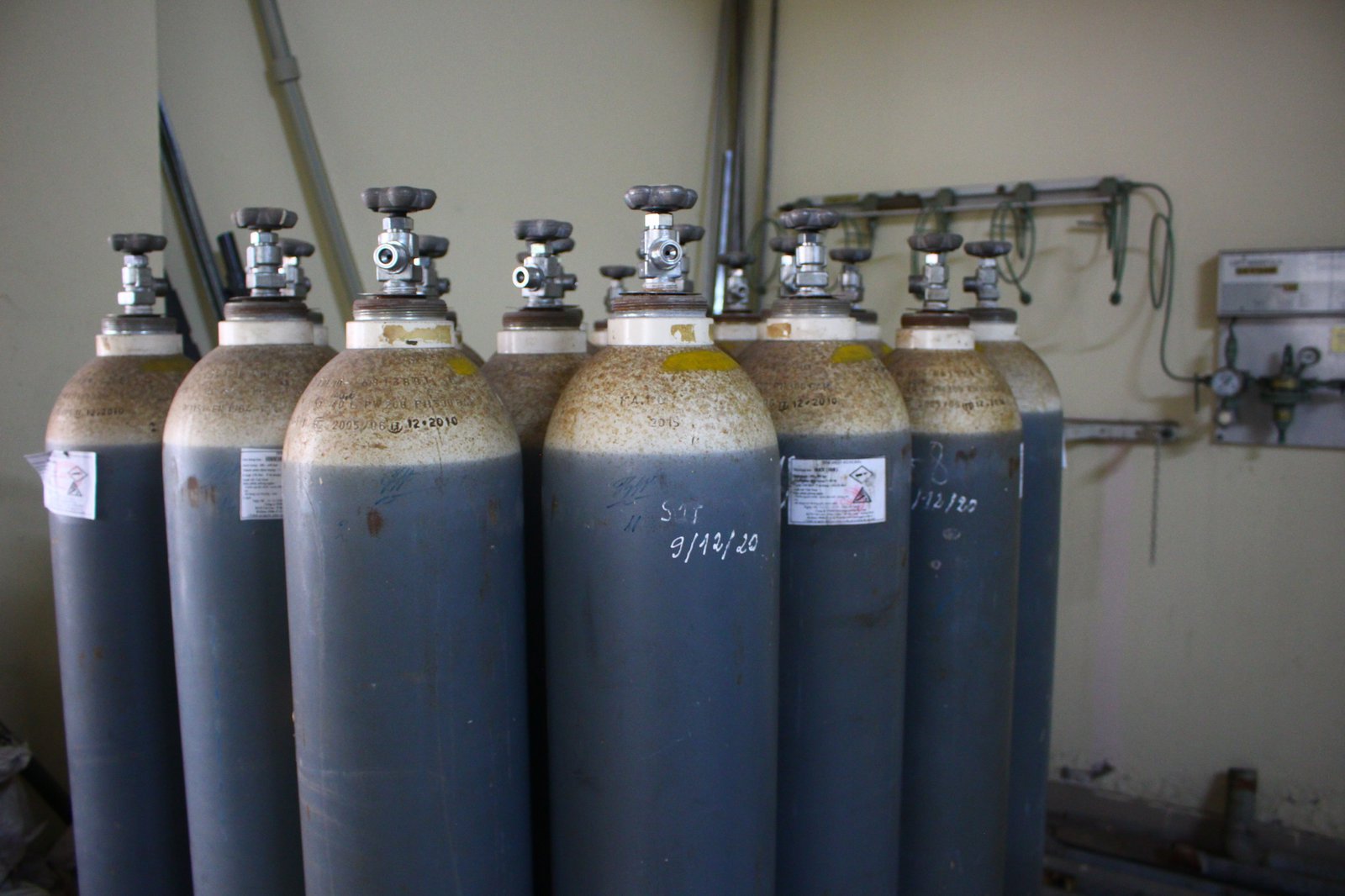Closing gaps in oxygen access and respiratory care
How PATH and Vietnam’s Ministry of Health (MOH) are working together to assess and address gaps in medical oxygen access and respiratory care during COVID-19.
Medical oxygen and respiratory care
Small- and large-scale gap analyses
Supply chain coordination
Accessing global funding sources

Chief of Vietnam Ministry of Health Cabinet Office Dr. Ha Anh Duc speaking at a workshop to disseminate countrywide survey results to national and regional stakeholders. Photo: PATH.
The challenge
Oxygen is not only an essential medicine needed to treat COVID-19 patients, but it is also an essential utility for hospitals, like water and electricity. These dual characteristics make it critical to understand the production, supply chain, and availability of medical oxygen within a health system to prepare for surges in demand. Unfortunately, there have been many instances during the COVID-19 pandemic of hospitals and health systems throughout the world running out of oxygen.
Until the spring of 2021, Vietnam had successfully controlled COVID-19 within its borders as the country saw only a few thousand cases, most being imported. However, the MOH remained vigilant. To prepare for potential outbreaks, ministry officials needed to understand the gaps and challenges of medical oxygen availability in Vietnam.
“Improving medical oxygen supply and respiratory care systems, which is central to pandemic preparedness and response, is achievable when we are fully aware of the gaps and challenges.”— Dr. Ha Anh Duc, Chief, Vietnam Ministry of Health Cabinet Office
Given the need to proactively manage the potential risks of the pandemic, PATH and the MOH worked together to conduct a small-scale analysis of gaps in respiratory care equipment and oxygen supplies in 27 hospitals in early 2021.
“Our analysis showed the hospitals were well-equipped to handle moderate COVID-19 outbreaks,” says Mr. Spike Nowak, Program Officer at PATH. “But additional hospitals would need to be mobilized for more serious outbreaks.”
The solution
PATH and the Ministry shared the analysis results with representatives from national health programs, local hospitals, the World Health Organization, and World Bank. Based on in-depth discussions with these stakeholders, PATH and the Ministry identified four key action items:
(1) Expand the analysis to study oxygen needs nationwide, especially how to increase the frequency of liquid oxygen deliveries.
(2) Establish a real-time oxygen equipment management system.
(3) Take advantage of global funding opportunities to procure more oxygen equipment.
(4) Develop larger pandemic scenarios in case infection levels rise.
In the following months, PATH and the Ministry’s Cabinet Office worked together to extend the analysis to 993 health facilities across Vietnam.
The results of the larger-scale analysis gave Ministry officials insight into the realistic needs of provinces and hospitals, as well as practical actions that could be taken to rapidly expand oxygen access.
PATH shared preliminary results of the nationwide survey and analysis with the US Agency for International Development (USAID) to support its work in increasing medical oxygen supplies, including funding additional liquid systems in Vietnam. PATH then coordinated with USAID; one of its existing grantees, FHI360; and the MOH’s partners to enhance oxygen systems for provinces in urgent need.
The MOH also established a tiered system of patient prioritization was also developed based on the severity of a patient’s symptoms. This system allowed the MOH to allocate resources more efficiently and create specific guidance on the equipment and medical oxygen needs for each tier. In conjunction with this system, an online platform was developed to track equipment usage in real-time so patients could be allocated to facilities with a sufficient amount of equipment.
PATH is supporting the ongoing development and use of this online platform so that patients are sent to facilities that can offer them proper care. We also provide assistance to volunteers in Ho Chi Minh City, Binh Duong, and Dong Nai provinces who participate in referring patients.
Why was PATH chosen to do this work?
PATH has been in Vietnam for more than 40 years. As rapid social and economic changes transform Southeast Asia, we are leveraging our thought leadership with governments, the private sector, and civil society to advance equitable access to health care across the region.
In Vietnam, we have worked on medical oxygen for nearly a decade. This work spans advocacy and policy design, market development, and product design. With the onset of COVID-19, the government of Vietnam chose PATH to help strengthen health systems to prevent the spread of the disease because of our:
- Trusted relationships with partners: For years, PATH has worked closely with government agencies, health care providers, laboratories, and communities in Vietnam to strengthen health security and pandemic preparedness and response. With COVID-19, PATH was able to quickly leverage our work to help the government develop and roll out COVID-19 vaccines and enhance electronic disease surveillance and reporting systems.
- Demand-driven technical collaboration: With more than 40 years of experience forging multisector partnerships, and with expertise in science, economics, technology, advocacy, and dozens of other specialties, PATH develops and scales up innovative solutions to the world’s most pressing health challenges. Our health professionals, analysts, and technical experts can meet a variety of stakeholder needs.
- Comprehensive oxygen experience: We have broad expertise in medical oxygen and recently developed and scaled up the Oxygen Delivery Toolkit.

Medical oxygen cylinders at a health facility in Vietnam. Photo: PATH.
Our approach
PATH partnered with the Vietnam MOH early in the COVID-19 pandemic and worked iteratively to expand the scope of our oxygen analysis. We have maintained collaborative, responsive, and transparent communications to ensure our analysis will timely and efficiently inform the officials, partners, and donors making evidence-based decisions in a rapidly changing environment. In summary, PATH is:
Responding to MOH needs
- Adjusting project plans and deliverables based on shifting priorities due to a dynamic COVID-19 situation.
- Conducting ad hoc analyses upon request to produce highly accurate information for decision-makers.
Being collaborative and transparent
- Sharing interim analysis results with partners and donors to take advantage of global funding opportunities for oxygen.
- Supporting the oxygen work of other organizations in Vietnam to coordinate and enhance response activities.
Building on our work
- Following our medical oxygen availability assessment in 27 hospitals, leveraging these learnings to 993 hospitals to identify nationwide gaps and challenges.
The results
PATH’s work over the course of 16 months facilitated both small- and large-scale gap analyses and resulted in new funding sources.
As the number of cases began to rise steeply in May 2021, the MOH, and the Vietnamese government in general, began quickly shifting response strategies. No longer was every positive case required to be hospitalized; field hospitals were quickly set up to ease the burden on hospitals already facing large caseloads; and staff and medical equipment were redistributed across the country to provinces most in need.
Medical oxygen was a major focus of emergency response activities. Liquid oxygen suppliers were convened to collect data on manufacturing capacity, the number of supply trucks, the delivery frequency, and the difficulties faced making deliveries so the government could alleviate these challenges. The MOH published guidance on ensuring adequate access to medical oxygen in times of high demand, and workshops were held to coordinate and exchange technical information on ensuring oxygen supplies.
“PATH’s work has not only identified and communicated the gaps and challenges we face, it's also provided critical information and indicated short- and long-term recommendations for the efficient delivery of oxygen and medical equipment.”— Dr. Ha Anh Duc, Chief, Vietnam Ministry of Health Cabinet Office
Funding
The COVID-19 Respiratory Care Response Coordination project, a consortium led by PATH, is supported by the Bill & Melinda Gates Foundation.
The project pursues strategies to help prioritize and improve access to oxygen therapy and other essential supplies for respiratory care as an integral part of health systems strengthening, beyond the pandemic response. For more information, please visit the COVID- 19 Respiratory Care Response Coordination project.
Resources
- Vietnam Respiratory Care Equipment Supplier Landscape
- Medical Oxygen Supplier Landscape in Vietnam
- Oxygen and Respiratory Care Equipment for COVID-19 Patient Management in Vietnam
- Description of the Procurement and Management Systems for Medical Equipment, Supplies, and Medical Oxygen at Health Facilities in Vietnam